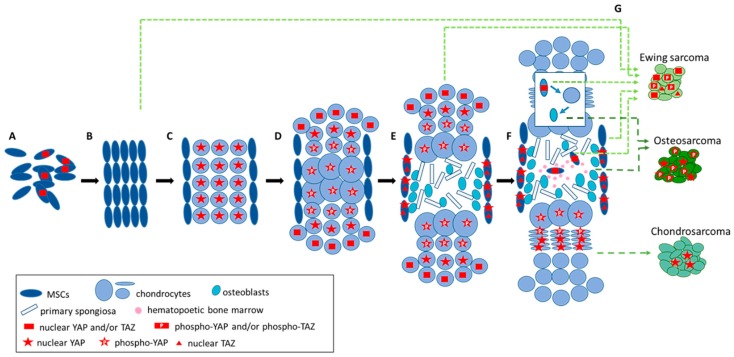Figure 3.
YAP and TAZ in endochondral bone development and most frequent bone cancers. (A) Mesoderm and neural crest-derived mesenchymal stem cells (MSC) (dark blue ovals) migrate to the site of limb bud formation. Here, TBX5 plays a pivotal role, for which YAP and/or TAZ (red squares) serve as co-activators. (B) MSC condense. Nothing is known about the status and activity of YAP/TAZ at this stage of bone development. (C) Condensed MSC differentiate to proliferating chondrocytes (small light blue circles), which produce parathyroid hormone related protein (PTHrP): peripheral MSC form perichondrium. Proliferating chondrocytes express active (nuclear) YAP (red stars). (D) Central chondrocytes arrest and become hypertrophic (large blue circles), which express Ser-phosphorylated, active YAP (red stars with inscribed white P) and Indian hedgehog (IHH). (E) Hypertrophic chondrocytes generate primary spongiosa (grey rectangles). Stiff extracellular matrix of primary spongiosa promotes the differentiation of perichondrial MSC into osteoblasts (turquois circles). YAP stabilizes nuclear β-catenin, and TAZ (red triangles) binds to SMAD4 co-activating RUNX2 to drive the osteoblastic differentiation program of perichondrial MSC and suppress adipogenic differentiation. These osteoblasts form the bone collar and invade the primary spongiosa to calcify the trabecular bone. (F) Growth plate forms columns of proliferating flat chondrocytes (light blue ovals), which express nuclear YAP (red stars), promoting SOX6 and suppressing SOX9 and Col10a1 expression, thus preventing chondrocyte maturation. Hematopoietic bone marrow (pink circles) invades with MSC (dark blue ovals), expressing active YAP and TAZ (red squares). Inserted window: Post-natal osteoblast generation by transdifferentiation from chondrocytes produced by self-renewing PTPrH expressing mesenchymal progenitor cells in an epiphyseal stem cell niche. Here, YAP and/or TAZ likely play a role in migration to sites of injury and bone regeneration. (G) Most frequent bone cancers with their hypothesized alternative origins indicated by dashed arrows. Ewing sarcoma most likely deriving from either early mesoderm or neural crest derived embryonal MSC, osteochondrogenic progenitors of the superficial zone or of the epiphyseal stem cell niche or from bone marrow MSC. Ewing sarcoma expresses nuclear and cytoplasmic YAP and TAZ (red squares with/without inscribed white P), but TAZ and TEAD-target gene activation is upregulated in rare tumor cells supposed to express low levels of EWS-FLI1. Osteosarcoma most likely deriving from osteoblasts expresses high levels of mostly cytoplasmic YAP (red stars with inscribed white P) with nuclear YAP (red stars), being associated with a bad prognosis. Chondrosarcoma supposed to originate from growth plate chondrocytes shows nuclear YAP (red stars) accumulation as a consequence of epigenetic large tumor suppressor kinases (LATS) inactivation as an independent bad prognostic factor. For simplicity, the figure does not consider the important role of osteoclasts in bone turnover.

